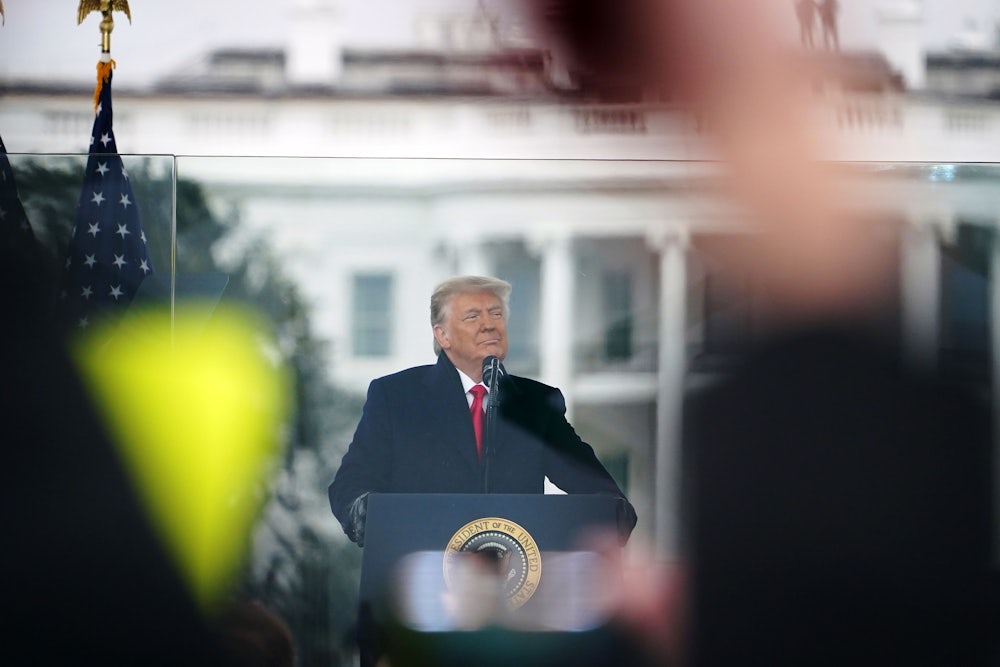It’s been almost three days since President Donald Trump incited a mob to attack Capitol Hill. So far, Facebook and Twitter have responded more forcefully to the attack on Congress than Congress has in its own defense. What should be the easiest case for impeachment in the history of the republic is languishing, thanks to the foot-dragging of Speaker Nancy Pelosi and House Democratic leadership.
On the surface, the Democrats seem to be moving toward impeachment for the second time. Pelosi announced on Thursday that she would pursue charges if Vice President Mike Pence and the Cabinet did not invoke the Twenty-Fifth Amendment to remove Trump from power. With Pence reportedly unwilling to do so, and Trump’s Cabinet all beating a path for the exit door, the House should now be moving with all possible haste to send articles to the Senate for trial. “While it’s only 13 days left, any day can be a horror show for America,” Pelosi warned.
Beyond that rhetoric, however, House Democrats have taken almost no steps to make this a reality. The House itself gaveled out on Thursday morning and isn’t scheduled to gavel back in until Monday. “We know that we have limited time but that every day that Donald Trump is president of the United States is a day of grave danger,” Massachusetts Representative Kathleen Clark, the assistant House speaker, said in an interview on Thursday. “So we can use procedural tools to get articles of impeachment to the floor for a House vote quickly.” She then said that the first vote wouldn’t come until the middle of next week, defying her own claims of haste.
The sluggish response by Pelosi and House Democratic leaders is not just misguided but dangerous. Trump pushed the American constitutional system to the brink by inciting a riot that killed five people and injured dozens of others. He will remain president for just under a fortnight, which might as well be an eternity. He can still issue pardons to his collaborators, prevent the National Guard from intervening in future incidents of unrest, and attempt to mount yet another bid to subvert American democracy. What more will it take for House Democrats to actually do something?
Compared to last year’s effort, building a case for impeachment is painfully straightforward. There are no mysterious Ukrainian figures to learn about, no complex webs of intrigue to untangle, no elliptical phone calls or text messages to decipher, and no need for a series of witnesses to fill in the details bit by bit to render it comprehensible. Americans watched as Trump, speaking at a rally outside the White House, told a crowd of his supporters to march on Capitol Hill. For most of the speech, he lied about voter fraud and falsely claimed the election had been stolen from him. Then he told his followers to take action.
“Now it is up to Congress to confront this egregious assault on our democracy,” he told the crowd. “And after this, we’re going to walk down and I’ll be there with you.” Trump did not actually march to Capitol Hill; he instead retreated back to the White House to watch the spectacle on television. “We’re going to walk down to the Capitol, and we’re going to cheer on our brave senators and congressmen and women, and we’re probably not going to be cheering so much for some of them,” he continued.
Trump did not explicitly say, “Go to Capitol Hill, beat up cops, and trash the place,” but he signaled to his supporters that extraordinary action was necessary and justified. “You’ll never take back our country with weakness,” he told the crowd. “You have to show strength, and you have to be strong. We have come to demand that Congress do the right thing and only count the electors who have been lawfully slated, lawfully slated.” His conclusion left no doubt about his intent. “Something’s wrong here, something is really wrong,” he said, describing the electoral outcome. “And we fight. We fight like hell. And if you don’t fight like hell, you’re not going to have a country anymore.”
It was the culmination of two months of vitriolic attacks on the election’s legitimacy. Biden won in a free, fair contest with historic levels of voter turnout, with no wrongdoing or serious fraud found by state governments or federal courts. Yet Trump persisted, out of malice or insecurity or some combination thereof, in delegitimizing the outcome under the guise of “exhausting his legal options.” As those options dwindled into nothingness, Trump turned his attention on Wednesday’s ceremony. He and his allies repeatedly told supporters that something big would happen in Washington on January 6. “Be there!” he wrote on Twitter. “Be wild!”
When the actual siege came, what did Trump do? He did not call off his supporters as they battered Capitol Police officers and broke down barricades. Trump’s first tweet was a sharp condemnation of Pence for refusing to throw out the election results. He posted a video a few hours later, praising the rioters and repeating his lies about the election, before meekly telling them to leave. There are open questions about whether he personally turned down requests from leaders in D.C., Maryland, and Virginia to deploy the National Guard, and grave indications that its eventual deployment did not come about through the standard chain of command. Only a day later, as Congress’s fury became apparent and the death toll grew, did he finally issue a video statement fully condemning the destruction.
Unlike in last year’s impeachment saga, Congress actually has considerable cross-partisan support to act. A number of leading conservatives have backed Trump’s removal, including once-stalwart Trump defenders such as National Review and the Wall Street Journal editorial board. “This was an assault on the constitutional process of transferring power after an election. It was also an assault on the legislature from an executive sworn to uphold the laws of the United States,” the Journal wrote. “This goes beyond merely refusing to concede defeat. In our view it crosses a constitutional line that Mr. Trump hasn’t previously crossed.”
Senate Republicans quashed the last bid to remove Trump almost exactly one year ago, with Utah Senator Mitt Romney casting the sole vote from among his party to find the president guilty of abuse of power. Whether enough GOP senators would vote for removal and disqualification this time is unclear. But they are not exactly rushing to defend him from calls for removal right now, either, and the prospect of removal and disqualification could serve as an effective deterrent against future abuses for the next two weeks.
Most importantly, what the House has right now is momentum. But House Democrats seem dead set on doing nothing. Those who can remember as far back as 2019 will recall that Pelosi and her allies were just as uninterested about bringing charges against Trump for obstruction of justice after the Mueller report’s release. Her response time in calling for impeachment after the Ukraine scandal became public was also moderate, at best. Indeed, the House Democratic leadership always seems to exhaust every other opportunity before doing the right thing. It appears as if they always want someone else to actually stand up to Trump before they do. Typically, they off-load that responsibility onto voters; with the Georgia runoffs concluded, there is little that voters can do before the 2022 midterms.
While it would have been helpful if Pence had used the Twenty-Fifth Amendment to remove Trump, it should not have precluded a drive toward impeachment. On Friday, Pelosi announced that she had contacted General Mark Milley, the top U.S. military official, to inquire about measures that would prevent Trump from launching nuclear weapons. There are no indications whatsoever that this is an immediate concern. More importantly, Pelosi has no constitutional authority to ask a general to ignore a direct order from the president. It’s hard to imagine a worse time to undermine the civilian control of the military than right after an attempted coup.
Unfortunately for House Democrats, there is no better or plausible alternative to impeachment right now. Trump is a clear and immediate threat to the republic. The Twenty-Fifth Amendment is designed for use in medical emergencies, not by sycophants in a constitutional crisis. Only Congress can remove him from office and prevent him from ever holding it again, and only the House can get the ball rolling. If they do nothing, they will only signal that what Trump did was not an impeachable offense and that no consequences are warranted. They will guarantee that future demagogues will see fit to attack them and their successors down the road.




